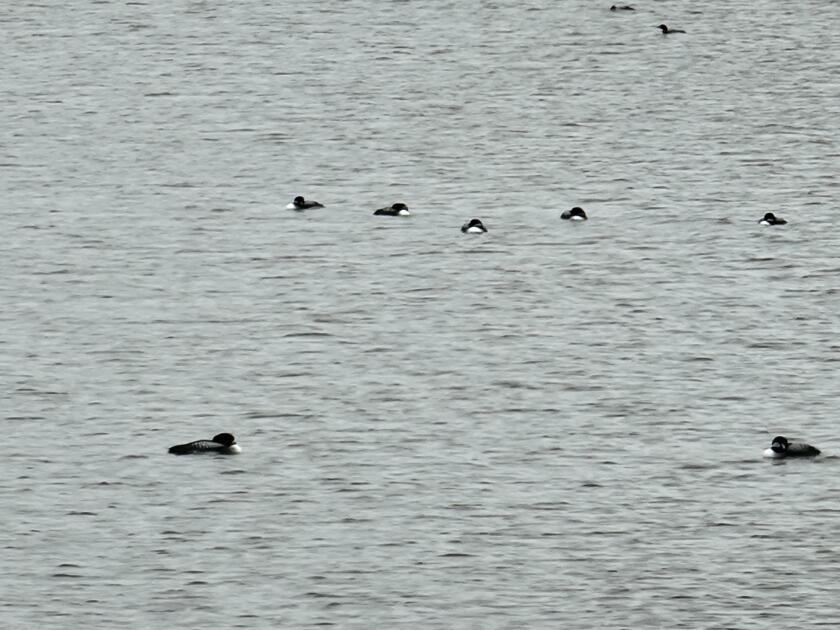WILLMAR — During a 17-years-career venturing about the wild lands of Kandiyohi County as a conservation officer with the Minnesota Department of Natural Resources, Michael O’Brien never witnessed a scene quite like the one he enjoyed from the relative comfort of his backyard last week.
He watched as an American eagle dive-bombed Willmar Lake, talons poised and ready. A splash of water and the bird emerged, pumping its wings for lift and with the weight of a walleye meal in the grip of its talons. The eagle promptly carried the prize to a tree in O’Brien’s yard.
ADVERTISEMENT
Nature’s drama continued on the lake in the days that followed, as O’Brien watched multiple loons drop in to bob on the waters and rest before continuing their northward migration.

Spring’s drama is exactly what led Ron Erpelding of Willmar to Chisago and Isanti Counties earlier this week. An avid birder, the spring migration is the best of times for him.
Yet Erpelding, like others who enjoy the outdoors, knows this as a spring where the drama of spring has been definitely slowed by cool temperatures and persistent winds. The birds are migrating pretty much on schedule, but they’re not so easy to find, he said. “They have to be somewhere but they are really tucked in when we’ve had these howling winds,” he explained.
The migration of geese and most waterfowl has already taken place, he noted. He spotted a red-breasted merganser on Foot Lake recently, and has seen plenty of other mergansers and buffleheads on its waters. They are usually the last of the waterfowl to migrate through, he pointed out.

“Spits and spurts” is how Randy Frederickson of Willmar describes this year’s weather and the migration tied to it. An avid birder as well, Frederickson said this spring’s late arrival can be costly for some bird species. Early arriving birds that rely on insects for feed are hurting. He bemoaned his first spotting of purple martins this year, knowing what it would mean.
One week ago, Erpelding spotted a number of Golden-crowned Kinglets hunkered low to the ground, scrounging up insects as best they could for the energy they need to reach nesting grounds much farther north.
In a more typical spring, we’d be seeing a general greening up of things by now. This year, even the dandelions remain elusive.
ADVERTISEMENT

Amy Rager of rural Chippewa County, leads the University of Minnesota’s Master Naturalist program and keeps a close eye on nature’s happenings around her. Until Thursday, she said she had yet to see her first pasque flowers emerge, although some of her colleagues in locations such as the West Metro have told her they are spotting some. Pasque flowers favor west-facing slopes. She suspects the persistent cold winds have delayed them from blossoming in these parts.
She has yet to see a mourning cloak butterfly, which is typically the very first butterfly to flutter on our prairies.
At the same time, Rager noted that most of our tree species are right on schedule. The maples produce a great sap run this year, she noted.
Walt Gessler, manager of the Lac qui Parle Wildlife Area, agrees that the spring green up is well behind schedule. He has yet to see any green on a small patch of prairie where a prescribed burn had been conducted, which otherwise is sure to trigger a green up.
Yet he pointed out that in other respects, nature is on schedule. The first of the season’s pelicans are riding the air currents over Marsh Lake preparing for their nesting season on the islands there. Local geese are preparing their nesting sites, he pointed out.

High drama is already a daily occurrence for Roger Strand at the Stoney Ridge Farm, where he maintains dozens of nesting boxes for wood ducks. Strand said he saw his first pair of wood ducks fly over in early March when the small lakes on the property across from Sibley State Park were still locked in ice. He watched as they put their heads down to look it over and seemed to say to each other: “We can’t come here yet. Have to have open water.”
Now they do have open water, and the nesting boxes are busy. A video camera in one of his boxes already revealed the season’s first eggs. “Things are really progressing now,” said Strand. “It’s hot stuff now.”
ADVERTISEMENT
The best is yet ahead, as the weather will inevitably warm and nesting gets into full swing. Earlier this week, Frederickson was busy in the warmth and protection of his garage. He’s building a raft that he will be placing on an area lake to serve as a nesting site for a pair of loons.
He’s noticed that some of the local loons are starting to scout for nesting sites.
Frederickson said a friend of his is keeping an eye on a pair of merlins that have been hanging around his place in Willmar for what had been 11 days straight. A type of falcon, merlins normally nest further north, but have been extending their nesting range south, said Frederickson. Perhaps this pair is checking out the local real estate to become the first nesting pair in Kandiyohi County.
He pointed out that about a dozen years ago, Kandiyohi County became the nesting home for a pair of osprey. Osprey seek out the highest of points for their nests, making them unusual in this landscape. A tower near New London has provided a nesting site for about a dozen years now. This year, it appears a tower in Willmar might host a second nesting pair.
Meanwhile, Erpelding is keeping his options open for spring adventures. He’s already seen a report of a mountain bluebird being spotted in Blue Earth County and of a Eurasian tree sparrow in Rice County. “There’s always some unusual things happening,” said Erpelding, “but not the level where they should be happening.” Like others, he expects that to change in a hurry.









